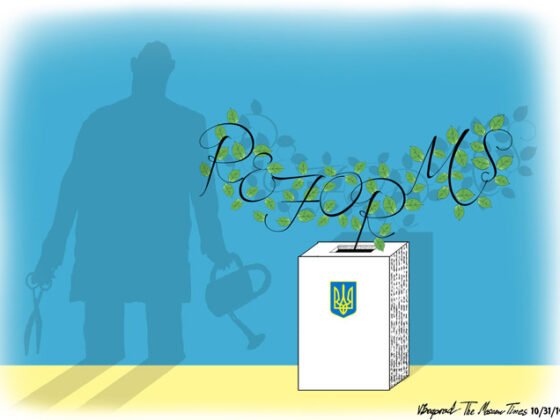Ukraine’s voting outcome might be interpreted as conditional confidence in the post-Euromaidan government. “Conditional” because the winning political actors will face challenges of unity when it comes to reform and security legislation. None of the parties can run the country without an alliance – at least three parties are needed to form a coalition. The efficiency and success of the government now depends on the ability of the political winners not to repeat the mistakes of the Orange revolution, when leaders wasted their historic chance by engaging in disruptive conflicts with each other. Here is my analysis of this election.
First, society proved unwilling to concentrate power in one person’s hands.
President Petro Poroshenko’s block, which was the frontrunner in all pre-election polls, lost at least 10% of the expected votes – it obtained 22% instead of the 30-35% that was projected. The newly created party People’s Front led by Primer Minister Arseniy Yatsenyuk received twice more than expected – 22% instead of 10-12%. Both of these “winning” parties can claim victory though both will need to prove their ability to build consensus, limit personal ambitions, and create sustainable, effective coalitions.
Second, society declared that they seek real reforms, not “business as usual.” This brought the Samopomich (“self-reliance”) party into the foreground as a winner, with 11% of the vote. Samopomich was founded and chaired by the Mayor of Lviv, Andriy Sadovy. Samopomich represents a new, post-Euromaidan, political face. It has no former MPs or governmental officials. The party list is mostly composed of young civic activists, in particular, a pro-reformist expert network that has developed dozens of draft legal bills aimed at anti-corruption, transparency, judiciary reform, public administration reform, etc. Samopomich started the campaign with just 2% support ratings, but came to symbolize the demands of society for a new generation of politicians who are seriously committed to reforms.
Third, the populist parties flopped. Two weeks before the election, pollster agencies predicted a second-tier result for the populist Radical party, but voters put it in fifth position (7.5%).
Fourth, traditional nationalists failed. Both far-right parties, Svoboda and Right Sector did not reach the 5% threshold (they received 4.7% and 1.8%, respectively). They will not have factions in the new parliament. Only a few individuals from these parties won in single-mandate constituencies (6 people and 2 poeple, respectively). This development substantially undermines Russian efforts to portray Ukraine’s current development as dominated by the far-right, fascists, and nationalists.
Fifth, Ukrainians said their ultimate “Good-bye to Lenin.” The Communists are out with just 3.8% of the vote, which has symbolic importance.
The electoral success of pro-Western reformist parties was impressive, but it does not guarantee the automatic success of Ukraine. Coalition talks will not be easy and the final composition of the government is still hard to predict. Hopefully, the sad lessons of the 2004-10 Orange era, when Ukraine wasted enormous opportunities, should serve as powerful reminders for the winners today. They must be determined to consolidate efforts to build sustainable democratic institutions that are based on the rule of law.
————
Also see Volodymyr Dubovyk’s Oct. 28 comment: An Overview of the Make-up of the New Ukrainian Parliament
Also see Henry E. Hale’s Oct. 26 comment: Ukraine's Election: Hope and Concern










